Content warning
This story may contain sensitive material or discuss topics that some readers may find distressing. Reader discretion is advised. The views and opinions expressed in this story are those of the author and do not necessarily reflect the official policy or position of Vocal.
The Aarushi Talwar Tragedy: Unraveling the Enigma of Noida's Mysteries
From Investigative Lapses to Media Frenzy: The Complexities of a High-Profile Case
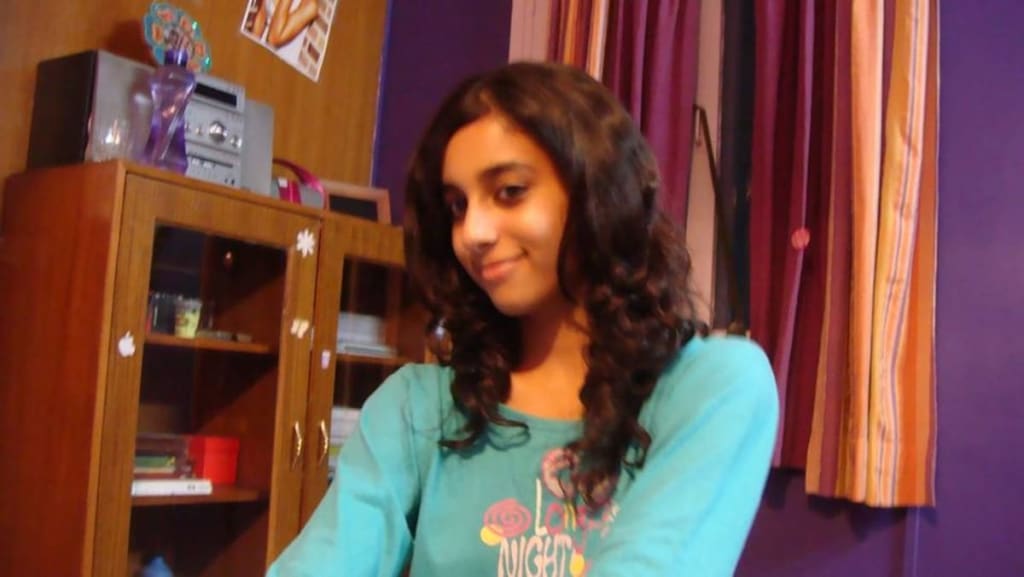
The Aarushi Talwar murder case is a high-profile case in India that occurred in 2008. Aarushi Talwar, a 14-year-old girl, was found murdered in her home in Noida, Uttar Pradesh. Initially, her parents were suspected, but the case took several twists and turns. Eventually, her parents were convicted of the murders, but the case remains controversial, with many questions surrounding the investigation and evidence.
Talwar murder case captured significant media attention and public interest in India due to its mysterious nature and the subsequent legal proceedings.
Aarushi Talwar, a 14-year-old student, was found dead in her bedroom on the morning of May 16, 2008, at her family's residence in Noida, Uttar Pradesh. Her throat had been slit, and there were other injuries on her body. Initially, the family's domestic servant, Hemraj, was suspected of the murder, as he was missing from the house. However, a day later, Hemraj's body was discovered on the terrace of the same building, also murdered.
The investigation took various turns, with suspicions initially falling on Aarushi's parents, Rajesh and Nupur Talwar. The police theorized that they had found Aarushi in an objectionable position with Hemraj and had then killed them both to cover it up. However, this theory was highly disputed and lacked concrete evidence.
The case was marred by botched investigations, alleged tampering of evidence, and sensational media coverage. Despite this, Rajesh and Nupur Talwar were arrested and charged with the murders of Aarushi and Hemraj. In 2013, they were convicted and sentenced to life imprisonment by a trial court.
However, in 2017, the Allahabad High Court acquitted the Talwars, stating that the prosecution's case against them was based on circumstantial evidence and lacked concrete proof. The court criticized the investigation for being flawed and criticized the trial court's judgment.
The Aarushi Talwar murder case remains one of the most intriguing and controversial criminal cases in India, with many unanswered questions and lingering doubts about the true perpetrators of the crime.

key dates and times related to the Aarushi Talwar murder case:
May 15, 2008:
Evening: Aarushi Talwar is at home with her parents, Rajesh and Nupur Talwar, in their residence in Noida, Uttar Pradesh.
May 16, 2008:
Early morning: Aarushi Talwar's body is discovered in her bedroom by her parents. Her throat has been slit, and there are other injuries on her body.
Later: The domestic servant, Hemraj, who was missing, becomes the prime suspect after his absence is noted.
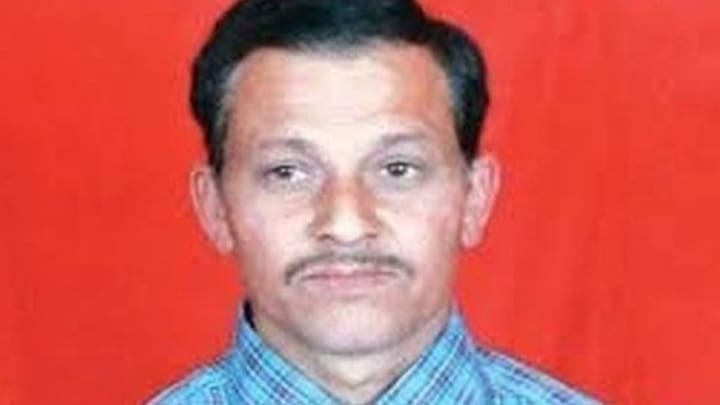
May 17, 2008:
Hemraj's body is found on the terrace of the Talwar residence. He too has been murdered.
Subsequent Investigation:
The investigation into the murders begins, with suspicions initially falling on Hemraj and then shifting to the Talwars, Aarushi's parents.
November 25, 2013:
Rajesh and Nupur Talwar are convicted by a trial court and sentenced to life imprisonment for the murders of Aarushi and Hemraj.
October 12, 2017:
The Allahabad High Court acquits Rajesh and Nupur Talwar, citing lack of concrete evidence and flaws in the investigation.
These are the key dates and events associated with the Aarushi Talwar murder case.
The truth in the Aarushi Talwar murder case has been elusive for several reasons:
Flawed Investigation: The initial investigation into the case was marred by incompetence, procedural errors, and alleged tampering of evidence. This compromised the integrity of the evidence and hindered the search for the truth.
Multiple Narratives: The case has been plagued by conflicting narratives and theories, making it difficult to ascertain what actually happened. Different parties have presented their own versions of events, leading to confusion and uncertainty.
Lack of Concrete Evidence: Despite extensive investigations and legal proceedings, there has been a lack of concrete evidence linking any specific individual to the murders of Aarushi Talwar and Hemraj. Without definitive evidence, it is challenging to establish the truth beyond a reasonable doubt.
Media Sensationalism: The case received widespread media coverage, which often sensationalized the details and influenced public perception. Media speculation and sensationalism may have clouded the search for truth and impeded the objective analysis of evidence.
Complexity of the Case: The Aarushi Talwar murder case is inherently complex, involving multiple individuals, conflicting accounts, and circumstantial evidence. Untangling the web of events and determining what actually occurred requires careful scrutiny and analysis.
Overall, a combination of these factors has contributed to the truth remaining elusive in the Aarushi Talwar murder case. Despite extensive investigations and legal proceedings, the case continues to be shrouded in uncertainty and controversy.
The final outcome of the Aarushi Talwar murder case was the acquittal of Rajesh and Nupur Talwar by the Allahabad High Court on October 12, 2017. The court overturned the previous conviction, citing a lack of concrete evidence and flaws in the investigation. As a result, the Talwars were released from prison after spending nearly four years behind bars. The case remains officially unsolved, with many unanswered questions and ongoing speculation about who was responsible for the murders of Aarushi Talwar and the family's domestic servant, Hemraj.
The Aarushi Talwar murder case has sparked various narratives and theories, each offering a different perspective on what might have transpired. Here are some of the different narratives surrounding the case:
1) Parental Involvement Theory:
This narrative suggests that Aarushi's parents, Rajesh and Nupur Talwar, were involved in the murders. It argues that they discovered Aarushi and Hemraj in a compromising position, leading to a violent confrontation that resulted in both murders. Proponents of this theory point to alleged inconsistencies in the parents' statements and behavior following the murders.
The parental involvement theory suggests that Aarushi Talwar's parents, Rajesh and Nupur Talwar, were directly responsible for her murder, possibly with Hemraj's involvement or as a cover-up for his murder. This theory gained traction during the investigation and trial of the case and was one of the main lines of inquiry pursued by law enforcement and the media. Here's a detailed breakdown of the theory:
Motive: Proponents of the theory argue that Rajesh and Nupur Talwar had a motive to kill Aarushi due to various factors, including alleged conflicts within the family, Aarushi's romantic relationship with Hemraj or another individual, and possible honor-related motives stemming from conservative societal norms.
Timeline of Events: According to the theory, Rajesh and Nupur Talwar may have discovered Aarushi in a compromising situation, such as engaging in intimate behavior with Hemraj or another person. This discovery allegedly led to a heated confrontation or altercation, ultimately resulting in Aarushi's murder.
Cover-Up: After Aarushi's death, the theory posits that Rajesh and Nupur Talwar may have conspired to stage the crime scene to make it appear as though an outsider, potentially Hemraj, was responsible for the murders. This could involve tampering with evidence, fabricating alibis, and misleading investigators.
Forensic Evidence: Supporters of the theory point to various forensic findings, such as the presence of Hemraj's blood on Aarushi's pillowcase and the absence of any evidence linking an outsider to the crime scene, as indicative of the parents' involvement in the murders.
Behavioral Analysis: Proponents of the theory may also analyze the behavior of Rajesh and Nupur Talwar before and after the murders, looking for inconsistencies, suspicious actions, or attempts to obstruct the investigation, which could suggest their guilt.
Legal Proceedings: During the trial, the prosecution likely presented evidence and arguments in support of the parental involvement theory, aiming to establish the Talwars' guilt beyond a reasonable doubt. Conversely, the defense would have sought to discredit this theory and present alternative explanations for the evidence.
Public Perception and Media Coverage: The parental involvement theory received extensive media coverage and public scrutiny, shaping public opinion and contributing to widespread speculation about the case. However, opinions on the Talwars' guilt or innocence remain divided, with some believing in their innocence and others convinced of their guilt.
Acquittal and Controversy: Despite being convicted initially, the Talwars were acquitted by the Allahabad High Court in 2017, which cited insufficient evidence to establish their guilt. The case continues to be a subject of controversy and debate, with lingering questions about the true perpetrators of the crime.
2) Intruder Theory:
According to this narrative, an unknown intruder or intruders entered the Talwar residence and committed the murders. Supporters of this theory argue that there is no evidence directly implicating the Talwars, and the crime scene suggests the involvement of an outsider. However, critics question how an intruder could enter and leave the house without leaving any significant evidence behind.
Introduction to the Theory: The theory proposes that Aarushi Talwar's murder may not have been committed by her parents or the domestic servants, as suggested by previous investigations and media reports. Instead, it posits that an unknown individual, referred to as X, may have targeted Hemraj, the Talwars' domestic help, and subsequently killed Aarushi.
Background on Hemraj: Hemraj, who was 45 years old at the time of his death, is depicted as a person with potentially complex social and financial relationships. The theory suggests that Hemraj may have owed money to X or had some form of contentious dealings with him.
Hemraj's Meeting with X: According to the theory, X contacted Hemraj on the night of the murders, likely demanding a meeting. Hemraj, who was familiar with X, agreed to meet him. The call was made from a public call booth, which explains why the caller's identity remains unknown.
Altercation and Murder: Upon X's arrival, an argument ensues between him and Hemraj, potentially related to financial matters or other unresolved issues. This argument escalates, leading to a physical altercation. X then fatally attacks Hemraj with a khukri, a type of Nepalese knife.
Encounter with Aarushi: As the altercation unfolds, Aarushi becomes aware of the disturbance and leaves her room to investigate. She encounters X, who, in a state of agitation, mistakes her for Hemraj and attacks her, resulting in her death.
Covering Tracks: After killing both Hemraj and Aarushi, X takes steps to conceal his involvement in the crime. This includes disposing of the murder weapons, tampering with evidence, and leaving the scene without arousing suspicion.
Evidence Supporting the Theory: The theory aligns with various pieces of evidence collected during the investigation, including unidentified fingerprints, the presence of Hemraj's blood on a scotch bottle, and the absence of a clear motive for Aarushi's parents or the domestic servants to commit the murders.
Unanswered Questions: Despite presenting a plausible narrative, the theory acknowledges the lack of concrete evidence regarding X's identity and motive. Further investigation would be required to identify X and gather additional evidence to support or refute the theory.
Overall, the theory offers an alternative perspective on the Aarushi-Hemraj murder case, highlighting the possibility of an unknown assailant targeting Hemraj, with Aarushi becoming an unintended victim of the confrontation.
This theory fits very well with all the (scant) evidence that we have.
• the unknown fingerprints in the house (not matching any suspects)
• unknown fingerprints on the scotch bottle
• the missing mobile phones that were recovered later
• the fact that someone called Hemraj that night from within 1km away and that when Nupur called Hemraj’s phone at 6am, it was within 1 km somewhere
• Hemraj’s room had beer and other drinks
• use of Hemraj’s bathroom (X was there for a long time and was drinking beer)
• Hemraj not eating his dinner that night
• Hemraj walking up the terrace himself (he had slippers on)
• the shoe prints were of number 8 or 9, while Rajesh wears size 6 or 7 indicating there was someone else on terrace with Hemraj (who was wearing slippers)
• bruises on Hemraj’s elbows
• hair in Hemraj’s mouth
• missing terrace keys
• Hemraj had no money and he stopped sending money home
• he mentioned about threat to his and his family’s life
• latch from outside on the grill door
• If this theory is correct then the question is who is X?
Who is X? I do not know - it could be one of the other servant suspects or it is possible that it was someone entirely different, the latter is more likely.
3) Domestic Servant Involvement Theory:
Some theories suggest that Hemraj, the Talwars' domestic servant, was involved in the murders or had knowledge of the events leading up to them. This narrative points to Hemraj's initial disappearance and subsequent discovery of his body as suspicious. However, it remains unclear how Hemraj could have committed the murders without leaving evidence implicating him.
Background of the Case
Initially, Hemraj was suspected of the murder because he was missing, but his body was found on the terrace of the Talwars' residence a day later.
Involvement of Domestic Servants- The involvement of domestic servants became a critical angle in the investigation, leading to multiple theories and arrests:
Hemraj Banjade:
Hemraj was the domestic servant of the Talwar household. He was initially considered a suspect until his body was discovered.His murder indicated the possibility of a larger conspiracy involving others who had access to the house.Other Domestic Workers and Acquaintances:
Krishna Thadarai: He was an assistant at Rajesh Talwar's dental clinic and a domestic help. He was initially arrested by the CBI on suspicion of involvement in the murders.
Rajkumar: Another domestic help employed by the Talwars' friends, the Durranis, who lived nearby. He was also arrested by the CBI.
Vikram: A helper at the nearby residence, who was also under suspicion.
Confession and Narco-Analysis:
The first CBI team conducted Narco Tests on 3 servants, Krishna Thadarai , the help at Rajesh’s dental clinic. Rajkumar, helper of the Duranis(pretty close friends of the Talwars) and Vijay Mandal, helper of Puneesh Tandon(Talwar’s neighbours)
All three of them had “confessed” their crime in trance state. I got to watch Tharadai’s leaked narco analysis and read the CBI document of Rajkumar’s statements but i found too many ambiguities and it seemed like they were being framed.
Krishna in his first statement said that he suspected Dr. Talwar for the murders but what I observed as the video proceeded , the doctor who was doing the narco test was putting words into his mouth, like “khukri” and “Hemraj ko kaise maara?”(trans:How did you kill Hemraj?).
Most importantly, all the servants had their alibis.
According to Krishna’s family members and landlord, he was at his home that fateful night.
Rajkumar was present at least till 12:30 am at the Duranis as Anita Durani had told.
Vijay Mandal hit his bed at 9:30 pm according to his employer Puneesh Tandon.
There had been no “hard interaction” on 16 May 2008 between them, Rajkumar didnt call Hemraj that day and Krishna had also not talked to Rajkumar.
In Rajkumar’s tranced confession, he alledged that he had killed Hemraj when he was unlocking the terrace door. But from the blood spurting effect that I had shown in the EVIDENCES that were never noticed before, It is implied that he was killed outside.
Rajkumar also told that he reached the Talwar’s appartment that night at 12 AM but he was present at the Duranis till 12:30. Moreover it takes 20 minutes to reach the Talwars from where he stayed by cycle.
There were no fingerprints of all the three found in Hemraj’s room or the whisky glasses that had been there
They told they had “destroyed” both the phones of Hemraj and Aarushi, but Aarushi’s phone was found near the park lying unconcealed. This shows how narco tests are unreliable.
Krishna, Rajkumar, and Vikram underwent narco-analysis tests, which allegedly indicated their involvement. However, the reliability of such tests was questioned.The CBI's initial theory suggested that these servants might have conspired together to commit the murders, possibly due to personal grudges or other motives.
No Concrete Evidence:
Despite extensive investigations and various forensic tests, no conclusive evidence was found to convict Krishna, Rajkumar, or Vikram.The case against them was primarily based on circumstantial evidence and inconsistencies in their statements.
Conclusion
The involvement of domestic servants in the Aarushi Talwar case remains one of the many controversial and unresolved aspects of the investigation. The initial focus on Hemraj and later on other domestic workers highlighted the complexities and potential biases in the investigation. However, due to the absence of definitive evidence, the precise role, if any, of these individuals remains a subject of speculation and debate.
4)Botched Investigation Theory:
Many believe that the investigation into the murders was deeply flawed and compromised by incompetence, corruption, and tampering of evidence. This narrative suggests that the failure of law enforcement to conduct a thorough and unbiased investigation hindered the search for the truth and allowed the real perpetrators to escape justice.
The Aarushi Talwar case, was plagued by numerous investigative errors and inconsistencies. This led to the widely accepted belief that the investigation was botched. Here’s an overview of the key aspects of the botched investigation theory:
Initial Mishandling
Crime Scene Contamination:
The crime scene was compromised from the beginning. Numerous people, including family, friends, and police officers, entered Aarushi’s room, contaminating potential evidence.Crucial forensic evidence may have been destroyed or altered due to the lack of proper crime scene management.
Delayed Discovery of Hemraj’s Body:Hemraj was initially considered the prime suspect. His body was found a day after Aarushi’s, on the terrace, despite the police being present at the Talwar residence. The delay in discovering Hemraj’s body indicated a lack of thoroughness in the initial investigation.
Flawed Forensic Handling
Inadequate Autopsies:
The postmortem examinations of Aarushi and Hemraj were criticized for being incomplete and lacking in detail.
The exact time of death was not accurately determined, and some injuries were not properly documented.
Botched Evidence Collection:
Crucial evidence, such as fingerprints and DNA samples, were not collected or were collected improperly.
The forensic analysis was inconsistent, with conflicting reports about key pieces of evidence like the murder weapon and bloodstains.
Shifting Theories and Suspects
Focus on the Talwars:
Initially, the investigation shifted focus from Hemraj to Aarushi’s parents, Rajesh and Nupur Talwar. This shift was based on circumstantial evidence and controversial psychological profiling.
The CBI presented a theory of honor killing, suggesting that the Talwars killed Aarushi after finding her in a compromising position with Hemraj. This theory was criticized for lack of concrete evidence.
Other Domestic Workers:
The police and CBI also arrested and questioned other domestic workers, including Krishna Thadarai, Rajkumar, and Vijay Mandal. These arrests were based on narco-analysis tests and confessions, which are not admissible in court These workers were later released due to insufficient evidence linking them to the murders.
Judicial Criticism and Acquittals
Special CBI Court Conviction:
In 2013, the special CBI court convicted the Talwars based on circumstantial evidence. The conviction was heavily criticized for relying on a flawed investigation and weak evidence.The court’s judgment was seen as an attempt to close a high-profile case rather than delivering justice based on solid evidence.
High Court Acquittal:
In 2017, the Allahabad High Court acquitted the Talwars, citing the investigative lapses and the lack of credible evidence. The court highlighted that the evidence presented was insufficient to conclusively prove the Talwars’ guilt.
The High Court criticized the investigative agencies for failing to conduct a thorough and unbiased investigation.
Public and Media Influence
Media Trial:
The media played a significant role in shaping public perception, often presenting speculative and sensationalized theories about the case.The intense media scrutiny put pressure on the investigative agencies, which may have influenced their handling of the case.
Conclusion
The botched investigation theory in the Aarushi Talwar case highlights how investigative errors, contamination of evidence, improper forensic handling, shifting theories, and media influence can derail the pursuit of justice. The initial lapses in the investigation created a chain reaction of missteps and controversies, ultimately leading to a lack of closure and ongoing debates about the true perpetrators of the crime
5) Media Sensationalism Theory:
Some narratives focus on the role of the media in shaping public perception and influencing the course of the investigation and legal proceedings. Critics argue that sensationalized media coverage of the case contributed to a rush to judgment against the Talwars and obscured the search for the truth.
The Aarushi Talwar case, often referred to as the Noida double murder case, became a media sensation in India, attracting unprecedented coverage and public interest. This intense media scrutiny significantly impacted the investigation and public perception of the case. Here's a detailed explanation of the media sensation theory:
Intense Media Coverage 24/7 News Cycle:
The case was extensively covered by news channels, newspapers, and online media platforms. The media frenzy began almost immediately after the discovery of Aarushi Talwar’s body and escalated with each new development.
The case was discussed round the clock, with live updates, special reports, and panel discussions featuring legal experts, psychologists, and former police officers.
Sensationalism and Speculation:
The media often focused on sensational aspects of the case, such as the alleged honor killing theory, supposed extramarital affairs, and lurid details about the victims’ personal lives.
Speculative reporting was rampant, with unverified information and rumors being presented as facts. This fueled public curiosity and outrage, creating a highly charged atmosphere around the case.
Impact on Investigation
Pressure on Investigative Agencies:
The relentless media scrutiny put immense pressure on the police and the Central Bureau of Investigation (CBI) to solve the case quickly. This pressure may have contributed to hasty conclusions and the shifting focus of the investigation.
Investigators faced the dual challenge of conducting a thorough investigation while managing media relations and countering negative publicity.
Shaping Public Perception:
Media coverage influenced public opinion, often painting the Talwars in a negative light. The portrayal of Aarushi’s parents as suspects based on circumstantial evidence and character assessments led to widespread public condemnation.
The narrative of a high-profile family involved in a scandalous crime captivated the audience, leading to prejudiced views about the case’s outcome even before the judicial process concluded.
Ethical Concerns and Trial by Media
Violation of Privacy:The extensive media coverage often disregarded the privacy of the victims and their families. Personal details about Aarushi and her family were publicly dissected, adding to the emotional trauma of the bereaved family.
Hemraj's family, too, suffered from the media’s insensitive portrayal of him, initially as a suspect and later as a victim.
Trial by Media:
The concept of a fair trial was undermined by the media’s role in shaping public opinion. The extensive coverage and speculative nature of reporting created a parallel trial outside the courtroom.
Media reports often presented their own conclusions, leading to a preconceived notion of guilt or innocence among the public, which could potentially influence judicial proceedings.
Judicial Criticism of Media Role
Court Observations:The judiciary criticized the media’s role in the case, highlighting that the intense coverage and speculative reporting could jeopardize the fairness of the trial.
The Allahabad High Court, in its judgment acquitting the Talwars, noted the adverse impact of media sensationalism on the investigation and trial process.
Conclusion
The media sensation theory in the Aarushi Talwar case underscores the profound impact of extensive and often irresponsible media coverage on criminal investigations and public perception. The case became a spectacle, with the media’s relentless focus on sensational details and speculative theories, influencing both the investigation and the broader societal view of justice. This highlights the need for ethical journalism and responsible reporting, especially in sensitive criminal cases, to ensure a fair and unbiased judicial process.
My take on this case
1)Impact Spatter/ Arterial Spurting found on the terrace door
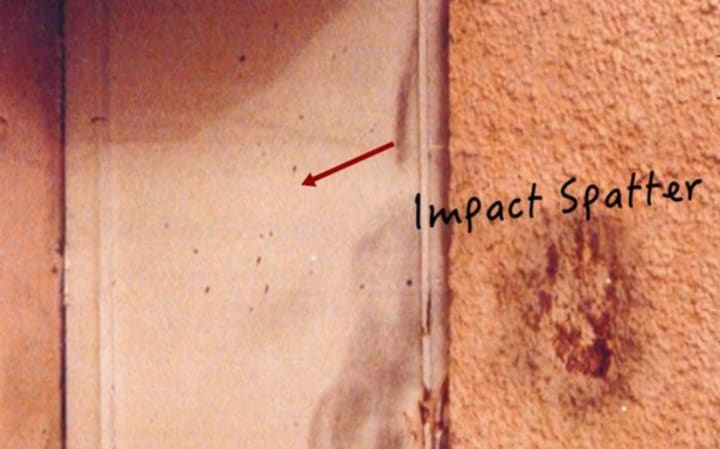
This is actually a very interesting observation because it proves something very significant
Hemraj was killed on the Terrace unlike what the CBI claimed that he was killed in Aarushi’s room
He was pretty much standing alive and was struck with the weapon near the door
He walked up himself upstairs and was not dragged
The person who killed him must have got blood on his shirt and his face also (gross!)
2)Hemraj’s activities that night and his threat to life
While I was doing my research on this case, I noticed something was missing, and it was the whereabouts of Hemraj that night. According to the Talwars they, had eaten their dinner by 10PM and they went to Aarushi’s room to gift the camera that had been received in the mail that particular morning. What we dont know is what was Hemraj exactly doing in between 10 o’clock and till the time of his murder( 12am to 1am in the night approximately). Moreover he had served himself dinner but didnt eat it. This is supported by the fact that there was only 25mL of liquid found in his stomach and his dinner was found untouched the next morning.This automatically arises the question that why didnt he eat dinner that night? Was he worried about “something” or anticipating something was going to happen?
Moreover he reported to a social worker a few days prior the grisly murder that he feared his life and his “dear ones” also he had not been sending any money back home for the past few months. This raises a red flag that something was indeed wrong in his life for a while.
(NOTE: I am not considering Hemraj’s widow (Khumkala Devi) statement that he feared Rajesh and Dinesh Talwar . Why was she saying this after 3 long years when the trial had begun? and moreover if he feared any of the Talwars, why would he be still working for them?)
3)Missing Mobile Phones and Aarushi’s phone being recovered in 2009
When the murders happened, Both Hemraj’s phone and Aarushi’s phone had gone missing, however Aarushi’s phone was recovered after one year from a man in Bulandshahr who was using it. According to him, he was given from his sister who was a domestic help in Noida which in turn she had found it lying in a Park unconcealed AFTER A FEW WEEKS OF THE MURDER. This means that someone placed (rather than dropped or disposed of) Aarushi’s phone in the park in a manner that would tempt a passer-by to pick it up. We need to also bear in mind that the phone had been formatted and the sim card of Aarushi was also missing.
At around 6 am in the morning, Nupur Talwar dialed Hemraj’s number from their landline and someone picked and disconnected within 2 seconds, and immediately it was switched off. It had connected to the Nitihari Cell Tower which lied in the radius of the Talwar’s house and the servant suspects also.
Hemraj’s phone was never recovered and the CBI claimed that it had been briefly active in Punjab but they had no evidences and facts supporting this dubious claim.
4) Call made to Hemraj from a PCO located in Sector 31
The last call made to Hemraj when he was alive was made from a PCO box located in Sector 31 at 8:27 PM. The person on the other end and Hemraj spoke to each other for approx 6 minutes. In my opinion this is the most important evidence that many people forget or dont know. We should also note that the investigators were not able to trace who actually called him that night. It is still unknown till this very day and no one either came to give their testimony to the police or court.
5)Missing terrace keys that were never recovered
A few days prior to the murders, Hemraj had started locking the terrace door because workers had started taking water from the tank, and the key remained with him. When Rajesh Talwar was asked for the terrace keys, he simply did not where the keys were. This was considered “suspicious” according to the investigators, but seriously it is equivalent to ask something you havent even heard of.
6) Unknown Fingerprints found on the whiskey bottle
There were indeed unknown fingerprints found on the whiskey bottle which didn’t match any of the parents or the servant suspects and the CBI admitted these during the trial
The fingerprints that belong to no one
"Leave an impression", says the tagline for Ballantine's scotch whisky. On Friday, the CBI presented a bottle of Ballantine's as evidence in the Aarushi Talwar case, and it turned out that there weren't any particularly useful impressions on it.
Debunking MYTHS and RUMOURS associated with the case
This case had probably so many rumours and myths that I honestly was shocked how stupid and bizarre these were and our great Indian public believed these. Researching this made me feel sick and disgusted on how far we can be shameless. I have tried my best to make this section error free and the explanations quite simple.. Any suggestions would be acceptable
1) Aarushi having a physical relationship with Hemraj and the so-called “Affair”
I think most of us know that Indian media is addicted to three things. Bollywood, Sex and Religion. When the murders happened, Indian news channels were on the rise. A double murder happening in an affluent neighbourhood in a city like Noida was quite a news that had already shook the nation. So to keep viewers glued to their CRT televisions and get that god damn TRP, they decided to add a cliché story of a 14 year old girl jumping in bed with a 45 year old helper and her dad bursting in the room and whacking both of them to death. At what cost? Shredding the character of both the victims and pinning the ghastly murder on the parents without even doing a background check of the family. And our Indian public believed all these “stories” because whatever we see on the news we take it for granted.. they believed this story because the Talwars were not seen as “grieving” family … they did not tear up or cry in front of the cameras… but who will tell our public that Ekta Kapoor serials aren’t applicable in real life :) ?
Did we have any solid evidence for backing up this story? You may feel that I am supporting the “Too-good-to-be-Talwars” but I am straight up putting facts here. There was not a single drop of Hemraj’s blood found in Aarushi’s room. The media is telling me that a 14 year old girl who is well educated, loves her parents dearly, has shown no sign of such erratic behaviour prior and any odd affair is seen as completely out of character by her close friends suddenly decides to bang bang with a 45 year old grandfather right next to her parent's room and whilst they're sleeping next door?
2)Dinesh Talwar requesting to hide “Rape” details in the post mortem report of Aarushi
This claim had surfaced when the trial against the Talwars was going on in mid 2012. KK Gautam, A retired DSP who helped in getting the post mortem of Aarushi done quickly now after 4 years of the incident testified that he had recieved a call from Sushil Choudhary, a friend of Dinesh Talwar to hide the “rape” angle as the family had requested and he did not pass on this request to Dr Sunil Dohare. I felt something odd here.. why was he saying this huge allegation after freaking 4 years? Moreover the statement that he said to the press of him seeing 3 glasses partially filled with whisky and depressions on the matress in Hemraj’s room now he was claiming that he never said these words.. I felt this was a fake tactic by the second CBI team to establish the honour killing motive. Sushil Choudhary on the other hand strongly denied these allegations and was never summoned to the court to record his statement.
3)Aarushi’s vagina being “severly dilated”, “unsually large” and her cervix being visible
WARNING: EXPLANATION IS GRAPHIC
Dr Sunil Dohare, who had conducted the post mortem report of Aarushi, on 16 may 2008 initially reported her vagina to be “Nothing Abnormal Found”. In the span of 3 years, he modified Aarushi’s post mortem report 6 times and in 2013 when the Talwars were facing trial, the post mortem report conatained that her vagina was severely dilated , was unusually large and her cervix was “clearly” visible. It is quite interesting to note here that Dr.Dohare had NEVER done an autopsy of a female body previously and when a gynaecologist had came to testify in the court, she said that female genitals simply dont work like that, even hypothetically let us say Aarushi was in the middle of sex with Hemraj(As AWFUL AS IT SOUNDS) , the vagina will not be dilated after the penis is removed unless and until it was held with instruments. Even after rigor mortis had set in and the vagina was cleaned, it would have injury marks and no injury marks were reported in the autopsy report. This is the reason why we need sex education since 3rd grade :/
When Dr Sunil Dohare was asked why he didnt mention it earlier, he said that he found these observations “very strange” and “non -specific”. Hold up.. Why didnt you mention these “strange” observations earlier?!!
4)The Parents “wierd” behaviour
This is probably one of the biggest reasons why the parents were considered as suspects.
Nupur Talwar’s face showed many of the signs of stress that one would expect from the sleepless nights that had followed her daughter’s murder and her husband’s arrest. There were moments when she looked close to breaking down, but she did not, could not—or would not—cry. The effect this had on the audience can still be seen in the comments sections of any story related to the murders. The overwhelming sentiment is that Nupur Talwar was cold, emotionless, a fake. From the investigations through the trial, Nupur Talwar’s ‘coldness’ was probably the one factor that weighed down the Talwars’ case the most. I honestly feel you should never judge someone just through their expressions and how they behave infront of the national television. A single statement can land them up in prison and one needs to be alert and give answers wisely.
5)Wet circular mark near Aarushi’s pelvis on the matress on she was found dead
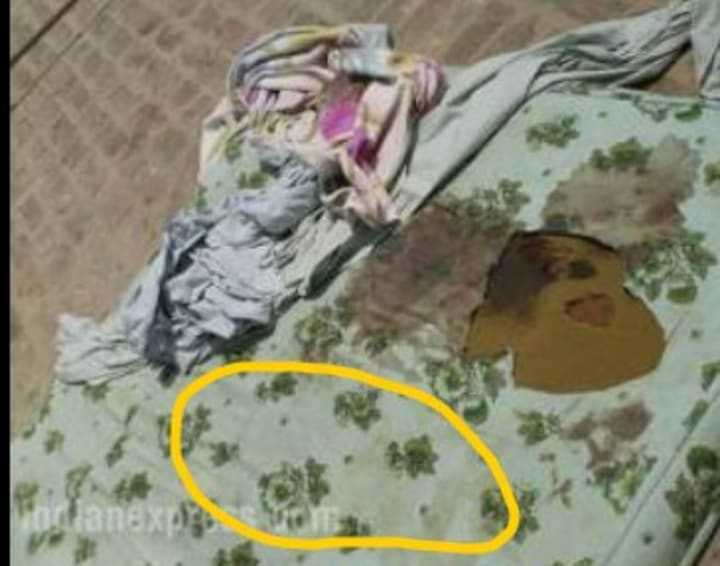
Probably one of the most stupid reasonings I have ever heard till this day. People were talking about this
It seemed like there was a wet mark on Aarushi’s pelvic area on the matress. The CBI claimed that this was due to Aarushi’s vaginal area being cleaned. I think the next image i will be showing would be enough to answer this
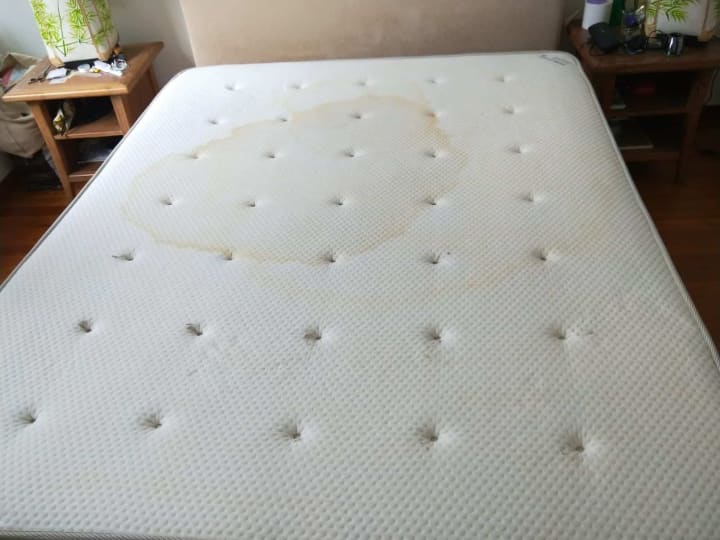
If you still did not get, yellow stains on matress are caused due sweating and humidity over time.
These are just a few of the different narratives and theories surrounding the Aarushi Talwar murder case. The case remains a subject of debate and speculation, with no definitive resolution to this day.
Conclusion
The perception that justice was not served in the Aarushi Talwar case stems from a combination of investigative failures, media sensationalism, judicial inconsistencies, and the presence of multiple conflicting theories. These factors collectively led to a situation where the true perpetrators of the crime were never conclusively identified, and the judicial process was marred by doubts and controversies. As a result, the case remains unresolved in the eyes of many, highlighting the challenges of achieving justice in a highly complex and publicized criminal investigation.
About the Creator
Enjoyed the story? Support the Creator.
Subscribe for free to receive all their stories in your feed. You could also pledge your support or give them a one-off tip, letting them know you appreciate their work.





Comments
There are no comments for this story
Be the first to respond and start the conversation.